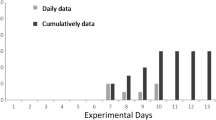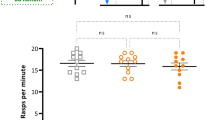Abstract
In this study, we demonstrate how an event that is initially frightening to Atlantic salmon is turned to a positive stimulus through habituation and associative learning. The study was carried out in four commercial sized tanks (5 m3) with near industry densities (>550 fish, 16 kg m−3), using a delay conditioning procedure with an aversive flashing light as the conditioned stimulus and food reward as the unconditioned stimulus. By using video image analysis of the distribution of the fish in the tanks, the changes in behaviour from trial to trial could be documented in great detail. The current study documents the change in behaviour across the individual conditioning trials, clearly showing the step-by-step nature of the transition. The salmon needed more than 26 trials to become fully habituated to the flashing light but showed clear anticipatory behaviour already after about 19 trials. This demonstrates that the learning process is a combination of habituation and associative learning.





Similar content being viewed by others
References
Boakes RA (1977) Performance on learning to associate a stimulus with positive reinforcement. In: Davis H, Hurwitz HM (eds) Operant-Pavlovian interactions. Erlbaum, Hillsdale
Crawley MJ (2007) Proportion data. In: Crawley MJ (ed) The R book. Wiley, West Sussex
Ellis T (2002) Key stressors in the aquaculture environment. In: Stead SM, Laird LM (eds) Handbook of salmon farming. Birkhäuser, Boston
Fernö A, Huse G, Jakobsen PJ, Kristiansen TS (2006) The role of fish learning skills in fisheries and aquaculture. In: Brown C, Laland K, Krause J (eds) Fish cognition and behaviour. Blackwell Publishing, Oxford
Fitzgerald R, Stefansson SO, Garforth D, Irwin S (2002) Stocking densities. In: Stead SM, Laird LM (eds) Handbook of salmon farming. Birkhäuser, Boston
Hearst E, Jenkins HM (1974) Sign-tracking: the stimulus-reinforcer relation and directed actions. Psychonomic Society, Austin
Lieberman DA (2000) Learning: behaviour and cognition. Wadsworth Publishing Co, Belmont
Lines JA, Frost AR (1997) Selective attraction of salmon. Aquac Eng 16:261–273
Milinski M (1993) Predation risk and feeding behaviour. In: Pitcher TJ (ed) Behaviour of teleost fishes, 2nd edn. Chapman and Hall, London
Mork OI, Gulbrandsen J (1994) Vertical activity of four salmonid species in response to changes between darkness and two intensities of light. Aquaculture 127:317–328
Mueller RP, Neitzel DA, Amidan BG (2001) Evaluation of infrasound and strobe lights for eliciting avoidance behavior in juvenile salmon and char. In: Coutant C (ed) Behavioral technologies for fish guidance. American Fisheries Society, Symposium 26, pp 79–89
Nilsson J (2008) Learning and anticipatory behaviour in cod and halibut. Dissertation, University of Bergen
Nilsson J, Kristiansen TS, Fosseidengen JE, Fernö A, van den Bos R (2008) Learning in cod (Gadus morhua): long trace interval retention. Anim Cogn 11:215–222
Schreck CB, Jonsson L, Feist G, Reno P (1995) Conditioning improves performance of juvenile Chinook salmon, Oncorhynchus tshawytscha, to transportation stress. Aquaculture 135:99–110
Spruijt BM, van den Bos R, Pijlman FTA (2001) A concept of welfare based on reward evaluating mechanisms in the brain: anticipatory behaviour as an indicator for the state of reward systems. Appl Anim Behav Sci 72:145–171
Stien LH, Bratland S, Austevoll I, Oppedal F, Kristiansen TS (2007) A video analysis procedure for assessing vertical fish distribution in aquaculture tanks. Aquac Eng 37:115–124
Thomassen JM, Fjæra SO (1991) Use of light signalling before feeding of salmon (Salmo salar). Aquac Eng 10:65–71
Tlusty MF, Andrew J, Baldwin K, Bradley TM (2008) Acoustic conditioning for recall/recapture of escaped Atlantic salmon and rainbow trout. Aquaculture 274:57–64
van den Bos R, Houx BB, Spruitj BM (2002) Cognition and emotion in concert in human and non-human animals. In: Bekoff M, Allen C, Burghardt G (eds) The cognitive animal: empirical and theoretical perspectives on animal cognition. MIT Press, Cambridge
Acknowledgments
This study has been carried out with financial support from the Commission of the European Communities, specific RTD programme “Specific Support to Policies”, SSP-2004-4-FISH—Area 8.1.B.1.3: Task 8, Project 022720 FASTFISH—on farm assessment of stress levels in fish (2006–2009). It does not necessarily reflect its views and in no way anticipates the Commission’s future policy in this area. The study has also been carried out with financial support from Research Council of Norway, Project 172487/S40 MORECARE—motivational states and coping ability as operational indicators in farmed fish. We are grateful to the staff of the Matre Aquaculture Research Station for their technical assistance. We would also like to thank two anonymous referees for valuable comments on the manuscript.
Author information
Authors and Affiliations
Corresponding author
Rights and permissions
About this article
Cite this article
Bratland, S., Stien, L.H., Braithwaite, V.A. et al. From fright to anticipation: using aversive light stimuli to investigate reward conditioning in large groups of Atlantic salmon (Salmo salar). Aquacult Int 18, 991–1001 (2010). https://doi.org/10.1007/s10499-009-9317-8
Received:
Accepted:
Published:
Issue Date:
DOI: https://doi.org/10.1007/s10499-009-9317-8




